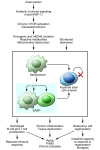Coming of age: molecular drivers of aging and therapeutic opportunities
- PMID: 23454756
- PMCID: PMC3582156
- DOI: 10.1172/JCI68833
Coming of age: molecular drivers of aging and therapeutic opportunities
Abstract
Aging is like the weather: everyone talks about it, but no one seems to do anything about it. We believe this may soon change, as an improved understanding of the molecular and genetic pathways underlying aging suggests it is possible to therapeutically target the aging process and increase health span. This Review series focuses on fundamental cellular mechanisms of aging and their relationship to human disease. These pathways include telomere dysfunction in cellular senescence and induction of the senescence-associated secretory phenotype (SASP) in systemic aging, sirtuin family regulation of metabolism and aging-associated diseases, mitochondrial metabolism in aging, the mechanistic target of rapamycin (mTOR) signaling pathway and the use of mTOR inhibitors to increase longevity, the progressive decline of the immune system with age, and aging-associated changes to pancreatic islet β cells that may contribute to diabetes. Together, these articles explore pathways affecting aging and possible interventional targets to slow or delay the onset of age-related pathologies.
Figures

References
-
- Bloom DE, Boersch-Supan A, McGee P, Seike A. Population aging: facts, challenges and responses. PGDA working paper No. 71, Harvard. http://www.hsph.harvard.edu/pgda/WorkingPapers/2011/PGDA_WP_71.pdf . Updated May 2011. Accessed January 18, 2013.
Publication types
MeSH terms
Substances
LinkOut - more resources
Full Text Sources
Other Literature Sources
Medical
Miscellaneous

